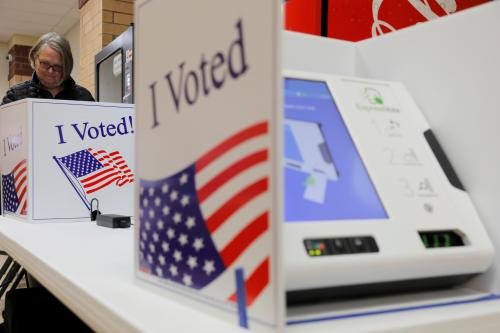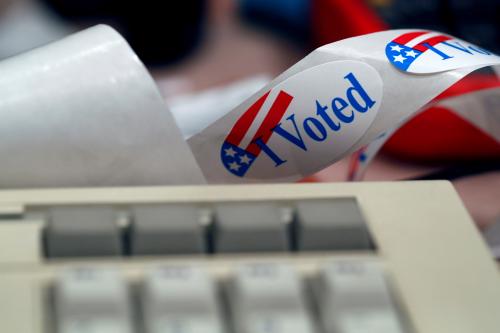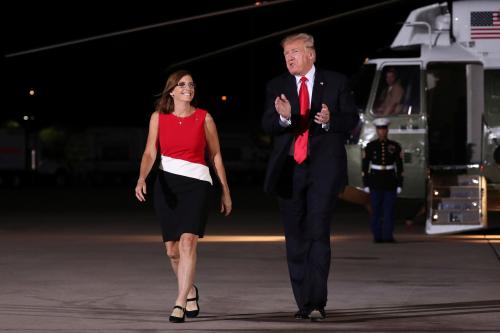The battle for control of the U.S. Senate is now more competitive than at any point in the 2020 election cycle. Record sums of money have poured into candidates’ coffers and outside spending in some states is at unprecedented levels. Democrats’ once-long shot chance of re-taking control of the Senate is looking increasingly likely, but state-level issues often affect U.S. Senate races, even during a presidential election. At FixGov, we asked scholars and experts on each state’s politics to contribute a brief discussion of the state of play and some of the underlying dynamics affecting individual races—a discussion that is often left out of national media coverage.
| States | ||
| Arizona | Michigan | Montana |
| Colorado | Iowa | North Carolina |
| Georgia | Kansas | South Carolina |
Arizona
Arizona for decades was a reliably Republican state, although former senators John McCain and Jeff Flake were somewhat unconventional Republicans. In 2018, Democratic candidate Kyrsten Sinema bested Republican Martha McSally to become Arizona’s first Democratic senator since the mid-1990s. In 2020, McSally is defending the seat formerly held by McCain to which she was appointed. She trails Democrat Mark Kelly in the pre-election polls. A changing electorate may explain both the 2018 and 2020 Arizona senate races.
Trends over the past few decades led to an Arizona electorate that has more Latinos, more college-educated white voters and fewer whites without those degrees. In addition, a survey conducted by Samara Klar and Chris Weber from the University of Arizona reveals that Arizonans in both parties are more moderate than often presumed. Finally, Arizona is a heavily urban state, with 60 percent of voters residing in Maricopa county, home of Phoenix and its suburbs. If some of those suburban voters split toward the Democratic Party, as they seem to be doing nationwide in 2020 and as they did in the 2018 Arizona senate race, this bodes well for Democrat Kelly. –Barbara Norrander, Professor of Political Science at The University of Arizona
Colorado
The race in Colorado between incumbent Senator Cory Gardner (R) and former Governor John Hickenlooper (D) will help determine the balance of power in the U.S. Senate. An early October poll conducted by the American Politics Research Lab at the University of Colorado at Boulder (CU) (10/5-10/9) found Hickenlooper with an 8-point lead over Gardner (48%-40%) among likely voters, with 11% of respondents indicating they were “undecided.” This margin has persisted in subsequent polling, and mirrors the CU poll’s numbers for the presidential contest (Biden +9). Trump is down in Colorado (by double digits in some surveys), which points to the theme of the Senate contest: can Gardner run away from Trump?
In debates and advertisements, Gardner has repeatedly tried to distance himself from the president, emphasizing his bipartisan credentials and work on behalf of all Coloradans. For his part, Hickenlooper has tried to tie Gardner to Trump, and has stressed Gardner’s past statements against the Affordable Care Act. In the CU poll, the gender margins in the presidential contest were substantial: Trump led among men in the state (43%-39%), but Biden led among women (56%-33%). This gap would seem to be a vulnerability for Gardner as well, for the poll found the Senate race tied among men (45%-45%), but Hickenlooper leading among women (51%-36%). A final wrinkle in the contest is that Colorado has been doing statewide mail voting since late 2013—as of October 30th, more than 50% of registered voters in the state had already returned ballots. Indeed, Gardner is trying to run away from Trump, but he’s running out of time, and much of the race has already been run. –Anand Sokhey, Associate Professor of Political Science at The University of Colorado at Boulder
Georgia
We are used to thinking of Georgia as a ruby-red state that has not voted Democratic for president since 1992. The truth is that Georgia’s partisan behavior is complex and has been showing signs of increasing competitiveness for a while. It did not finish its secular realignment toward the GOP until 2010 (the year Republicans won all of the statewide offices). And when we look at margins in first-ballot Senate contests in the last 40 years, we find both Democratic and Republican candidates winning by narrow margins in the 1980s through the mid-1990s. Indeed, the only Republican Senate candidate who consistently won by double-digit margins was Johnny Isakson, whose permanent replacement will be determined by this year’s special election.
While the special election features more than a dozen and a half candidates, three stand out. Raphael Warnock, the pastor of Martin Luther King’s Ebenezer Baptist Church, has emerged as the leading Democratic candidate. The incumbent appointed to replace Isakson, Senator Kelly Loeffler, faces steep competition from Congressman Doug Collins for Republican votes. Given the number of candidates in the race and Georgia’s mandate that election winners take a clear majority of the vote, most expect this race to head to a December runoff. Warnock will almost certainly advance. The question is, which leading Republican will end up in second place? The polls are too close to predict the Republican finalist. Collins and Loeffler have split key endorsements. And President Trump has not expressed a clear preference for either Republican, who have both tried to highlight their loyalty to Trump as a campaign asset. Republicans hope to consolidate around the eventual second-place winner in a runoff election and hope that Democrats will lose steam. If, however, partisan control in the Senate hangs in the balance after all of the other Senate races are decided, we should expect a long, intense, and expensive runoff election season.
As with just about all of the competitive senate races nationally, President Trump’s coattails have important implications for the down-ballot contests. Regardless of who wins the presidential race in Georgia, I expect the margin to be even more narrow than the five points by which Donald Trump beat Hillary Clinton in 2016. This poses challenges for Republicans like Loeffler, Collins, and David Perdue (who is facing upstart Jon Ossoff[1] in the regularly scheduled senate race). They should not expect many Biden voters to split their votes down-ballot. And if Joe Biden scores the upset he clearly wants in Georgia, this will help both Ossoff and Warnock, and may help them both avoid runoffs—although there is a Libertarian candidate in the Perdue-Ossoff race who could play spoiler. –Andra Gillespie, Associate Professor of Political Science at Emory University
Iowa
For the Iowa Senate race, it’s back to the old adage that all politics is local. Though we typically think about Senate candidates being subject to national forces during a presidential election year, two Iowa-centric issues might swing the race in either direction for Senator Joni Ernst and her Democratic challenger Theresa Greenfield. First, farmers in Iowa have had a rough few years, capped by the August derecho that destroyed much of 2020’s crop. Being tuned in to agriculture in the state is a must, and Ernst’s inability to name the current “break-even” price on soybeans in a recent debate might cost her a key demographic. Second, persistently high COVID-19 cases across the state have handed the current Republican governor—Kim Reynolds—a record-low approval rating. (At 26%, she is the most unpopular governor in the United States.) Even though the governor herself is not on the ballot in 2020, in a state that voted for Obama twice and then overwhelmingly for Trump, voters certainly change their minds. Dissatisfaction with Republican state government might hurt Ernst’s reelection chances. –Tracy Osborn, Associate Professor of Political Science and Senior Fellow at the Iowa Public Policy Center, University of Iowa
Kansas
Kansas has not elected a Democrat to the Senate since 1932, but 2020 gives Democrats their best shot in decades of breaking that streak.
The Democrat is State Senator Barbara Bollier, a former moderate Republican from the increasingly blue Kansas City suburbs. The Republican is Congressman Roger Marshall—a generic conservative from western Kansas. Both are doctors, but share little else in common.
Bollier has defied the “conventional wisdom” that once held that her only opening in the race was for Republicans to nominate Kris Kobach, a controversial conservative who was their unsuccessful 2018 nominee for governor. As of mid-October, she had out-raised Marshall $24.3 to $5.9 million. The candidates have attracted over $40 million in outside spending, and polling has generally shown no clear leader in the race.
In polls, undecided Senate voters lean to Donald Trump for president. To win, Bollier needs ticket splitters—probably Trump voters who are Republican by habit, but less partisan and conservative. Health care appeals and endorsements from Republican politicians, including former U.S. Senator Nancy Kassebaum, dominate her appeals to these voters.
Conversely, Republican messaging focuses on machine-gunning numerous issues—abortion, guns, and health care, for example—at voters, unified by a common theme of labeling Bollier as “extreme” rather than moderate. The goal is to unite Trump voters behind Marshall.
Depending on turnout, Bollier needs perhaps 15-20% of Trump voters to support her. That may be a tall task with Trump himself on the ballot, but one she must tackle to win. –Patrick R. Miller, Associate Professor of Political Science at the University of Kansas
Michigan
The 2020 Senate race between Gary Peters and John James is on track to become the most expensive political race to take place in Michigan history. Peters and James are both positioning themselves as nonpartisan moderate candidates, and while Peters has been in office for six years, he is not well-known among his constituents. Each party is expected to pour $100 million into this election. Heightened attention to this contest stems from efforts by Democrats to not only hold on to current Senate seats, but also gain additional ones to retake the chamber. On the flipside, 9 of the 35 Senate seats up for election this year, including the Michigan seat, are rated as either toss-ups or Democratic leaning. By mid-October, polls were finding variation in Peters’ lead over James, though a New York Times and Siena College poll indicated that the incumbent Senator Peters was just 1 percentage point ahead of Republican challenger John James. Recent polls, however, suggest that the Democrats’ investment in the race is paying off. As of the Wednesday before the election, Peters had a 10-point lead over James, winning 91.3% of Biden voters, 6.4% of Trump voters and an equal percentage of undecided voters. –Nazita Lajevardi, Assistant Professor of Political Science at Michigan State University
Montana
Though the race has been under the radar nationally, publicly available polling shows that the U.S. Senate race in Montana is among the most competitive in the country—as it has been since Steve Bullock, Montana’s term-limited governor, announced his bid to unseat incumbent first-term Senator Steve Daines. Though reliably red at the presidential level, Montana has long been competitive down ballot.
Key to Bullock’s prospects is whether he can localize the race as a decision on who best understands Montana and its unique needs. Daines, meanwhile, is doing his best to nationalize the race, framing it as a decision between a loyal foot soldier to Trump versus a would-be crony for national Democrats such as Nancy Pelosi.
Localizing elections isn’t new for Montana Democrats and they successfully did so as recently as 2018. But this is their greatest challenge yet as the state’s political dynamics have changed. Specifically, the best indication that nationalization has begun to gain a foothold in Big Sky Country is that Republicans are favored in all statewide races even as Trump appears destined to win by single digits—the last time a Republican presidential candidate won Montana by single digits was in 2008, when Democrats swept six of the other seven statewide races. –Kal Munis, Postdoctoral Research Associate at Johns Hopkins University
North Carolina
Prior to early October, Democratic challenger Cal Cunningham seemed poised to tilt the tossup U.S. Senate seat held by Republican Thom Tillis into the lean-Democratic category. Cunningham led in 13 of 13 polls conducted in September by an average of 5 percent. Cunningham, an attorney and veteran who emphasized his family values and small-town roots, pitched a campaign to appeal to unaffiliated voters while relying on anti-Trump sentiment to rally his Democratic base. Then revelations of Cunningham having a recent extramarital affair emerged in early October. Cunningham has largely avoided discussing the affair since his initial acknowledgement and apology. The Tillis campaign and its supporters launched widespread ads reminding voters of the scandal. Some ads are particularly emotional and feature other veterans depicting Cunningham as an “oath breaker” because his relationship occurred with the wife of a disabled veteran. The average of recent polls in North Carolina show Cunningham’s lead has fallen to 1.3% (a margin far too close to say either candidate has an actual lead). While this decline from Cunningham’s September advantage could be due to other factors, it seems reasonable to assume the affair has cost Cunningham a substantial number of votes. The impact of the scandal seems moderate in comparison to effects of these events on historical campaigns. However, a moderate impact is all that is needed to change the outcome of an election in a swing state like North Carolina and, potentially, to change the party in control of a closely divided U.S. Senate. –Jason Husser, Associate Professor of Political Science and Policy Studies at Elon University
South Carolina
South Carolina is a Republican state. No Democrat has won statewide political office since 2002. Whether Democratic candidate Jaime Harrison can change that structural reality will decide this race. He would need to expand the electorate by mobilizing African American and younger voters in record numbers, and he would still need to win some Republican voters. What allows Democrats to entertain that possibility is Senator Lindsey Graham’s complete about-face on Donald Trump over the last four years. During the 2016 campaign, Graham’s blunt and often colorful derision of Trump was widely publicized. Four years later, Graham is golfing with the president and passionately defending him. While that shored up Graham’s support from more conservative voters who have historically viewed him suspiciously because of his work with Democrats, it has soured Democrats and independents who have often voted for Graham. Whether this transformation has cost Graham support among Republicans who are disenchanted with Trump is unclear. With his record-breaking fundraising, Harrison has hammered the theme “What happened to Lindsey Graham?” and outside groups have been happy to provide specific examples including Graham’s failure to defend John McCain from Trump’s attacks. But South Carolina is still a Republican state—until it’s not. –Danielle Vinson, Professor of Politics and International Affairs at Furman University
The editors wish to thank Saku Gopinath for her assistance with this post.
[1] Jon Ossoff rose to prominence in 2017 when he nearly beat Karen Handel in the special election to replace former HHS Secretary Tom Price in Georgia’s 6th Congressional District—the seat that was formerly held by Newt Gingrich. That contest is, to date, the most expensive congressional race ever.
The Brookings Institution is committed to quality, independence, and impact.
We are supported by a diverse array of funders. In line with our values and policies, each Brookings publication represents the sole views of its author(s).











Commentary
Race for the Senate 2020: Experts’ views from the states
October 30, 2020